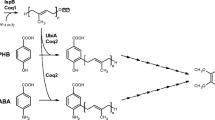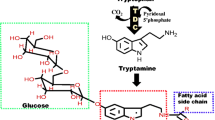Abstract
A filamentous fungus Aspergillus terreus produces itaconic acid, which is predicted to be derived from cis-aconitic acid via catalysis by cis-aconitic acid decarboxylase (CAD) in the carbon metabolism of the fungus. To clarify the enzyme’s function and a pathway for itaconic acid biosynthesis, we cloned a novel gene encoding the enzyme. The open reading frame of this gene (CAD1) consists of 1,529 bp encoding 490 amino acids and is interrupted by a single intron. Among the identified proteins in the database, the primary structure of the protein encoded by CAD1 shared high identity with the MmgE/PrpD family of proteins, including a number of 2-methylcitrate dehydratases of bacteria. The cloned gene excluding an intron was introduced into the expression plasmid pAUR-CAD1 controlled by the ADH1 promoter. The CAD activity in Saccharomyces cerevisiae was confirmed by directly detecting itaconic acid as a product from cis-aconitic acid as a substrate. This result reveals for the first time that this gene encodes CAD, which is essential for itaconic acid production in A. terreus.




Similar content being viewed by others
References
Bentley R, Thiessen, CP (1957a) Biosynthesis of itaconic acid in Aspergillus terreus. I. Tracer studies with 14C-labeled substrates. J Biol Chem 226:673–687
Bentley R, Thiessen CP (1957b) Biosynthesis of itaconic acid in Aspergillus terreus. II. Early stages in glucose dissimilation and the role citrate. J Biol Chem 226:689–701
Bentley R, Thiessen CP (1957c) Biosynthesis of itaconic acid in Aspergillus terreus. III. The properties and reaction mechanism of cis-aconitic acid decarboxylase. J Biol Chem 226:703–720
Bradford MM (1976) A rapid and sensitive method for the quantitation of microgram quantities of protein utilizing the principle of protein–dye binding. Anal Biochem 72:248–254
Brock M, Maerker C, Schutz A, Volker U, Buckel W (2002) Oxidation of propionate to pyruvate in Escherichia coli. Involvement of methylcitrate dehydratase and aconitase. Eur J Biochem 269:6184–6194
Calam CT, Oxford AE, Raistrick H (1939) Studies in the biochemistry of microorganisms. LXIII. Itaconic acid, a metabolic product of a strain of Aspergillus terreus Thom. J Biochem 33:1488–1495
Cheng J, Saigo H, Baldi P (2006) Large-scale prediction of disulphide bridges using Kernel methods. Two-dimensional recursive neural networks, and weighted graph matching. Proteins 62:617–629
Dwiarti L, Yamane K, Yamatani H, Kahar P, Okabe M (2002) Purification and characterization of cis-aconitic acid decarboxylase from Aspergillus terreus TN484-M1. J Biosci Bioeng 94:29–33
Elble R (1992) A simple and efficient procedure for transformation of yeasts. Biotechniques 13:18–20
Goda H, Nagase T, Tanoue S, Sugiyama J, Steidl S, Tuncher A, Kobayashi T, Tsukagoshi N, Brakhage AA, Kato M (2005) Nuclear translocation of the heterotrimeric CCAAT binding factor of Aspergillus oryzae is dependent on two redundant localising signals in a single subunit. Arch Microbiol 184:93–100
Horton P, Park K, Obayashi T, Nakai K (2006) Protein Subcellular Localization Prediction with WoLF PSORT. In: Proceedings of the 4th Annual Asia Pacific Bioinformatics Conference APBC06, Taipei, Taiwan, pp 39–48
Kato M, Aoyama A, Naruse F, Tateyama Y, Hayashi K, Miyazaki M, Papagiannopoulos P, Davis MA, Hynes MJ, Kobayashi T, Tsukagoshi N (1998) The Aspergillus nidulans CCAAT-binding factor AnCP/AnCF is a heteromeric protein analogous to the HAP complex of Saccharomyces cerevisiae. Mol Gen Genet 257:404–411
Kinoshita S (1931) Über die produktion von itaconsäure und mannit durch einen neuen schimmelpilz. A itaconicus. Acta Phytochim Jpn 5:271–287
Kudla B, Caddick MX, Langdon, T, Martinez-Rossi, N, Bennett, CF, Sibley, S, Davies, RW, Arst HN (1990) The regulatory gene areA mediating nitrogen metabolite repression in Aspergillus nidulans. Mutations affecting specificity of gene activation alter a loop residue of a putative zinc finger. EMBO J 9:1355–1364
Lockwood LB, Reeves MD (1945) Some factors affecting the production of itaconic acid by Aspergillus terreus. Arch Biochem 6:455–469
Xing Y, Fikes JD, Guarente L (1993) Mutations in yeast HAP2/HAP3 define a hybrid CCAAT box binding domain. EMBO J 12:4647–4655
Yahiro K, Takahama T, Park EY, Okabe M (1995) Breeding of Aspergillus terreus mutant TN-484 for itaconic acid production with high yield. J Ferment Bioeng 79:506–508
Acknowledgment
We acknowledge the financial support by the comprehensive support program for the creation of regional innovation in the Japanese Science and Technology Agency (JST).
Author information
Authors and Affiliations
Corresponding author
Rights and permissions
About this article
Cite this article
Kanamasa, S., Dwiarti, L., Okabe, M. et al. Cloning and functional characterization of the cis-aconitic acid decarboxylase (CAD) gene from Aspergillus terreus . Appl Microbiol Biotechnol 80, 223–229 (2008). https://doi.org/10.1007/s00253-008-1523-1
Received:
Revised:
Accepted:
Published:
Issue Date:
DOI: https://doi.org/10.1007/s00253-008-1523-1




